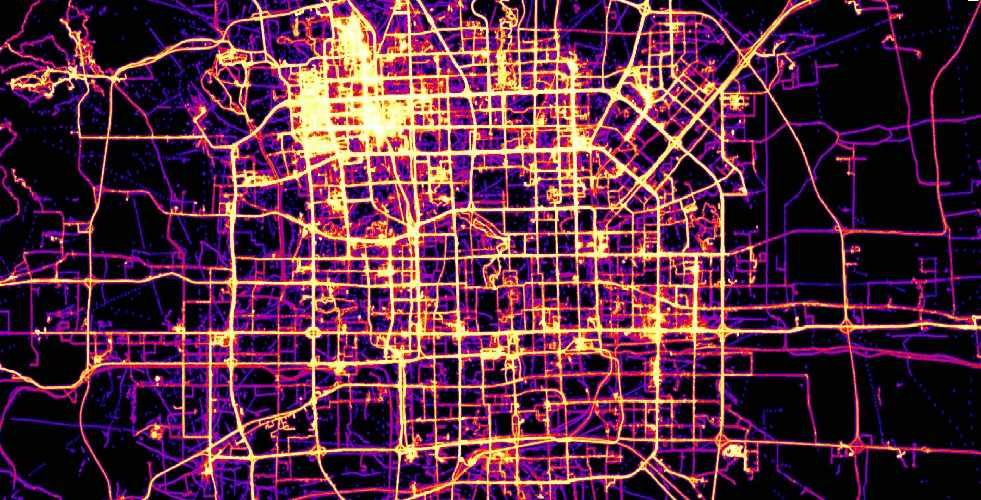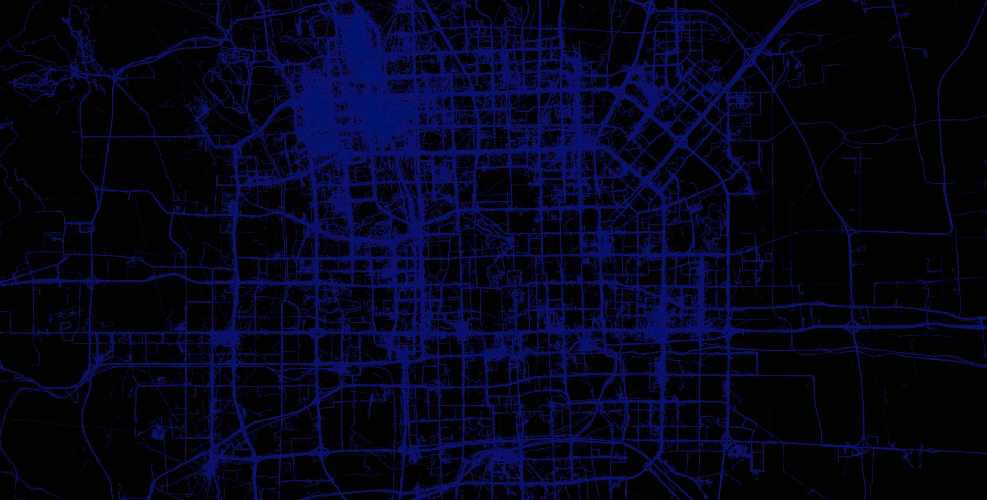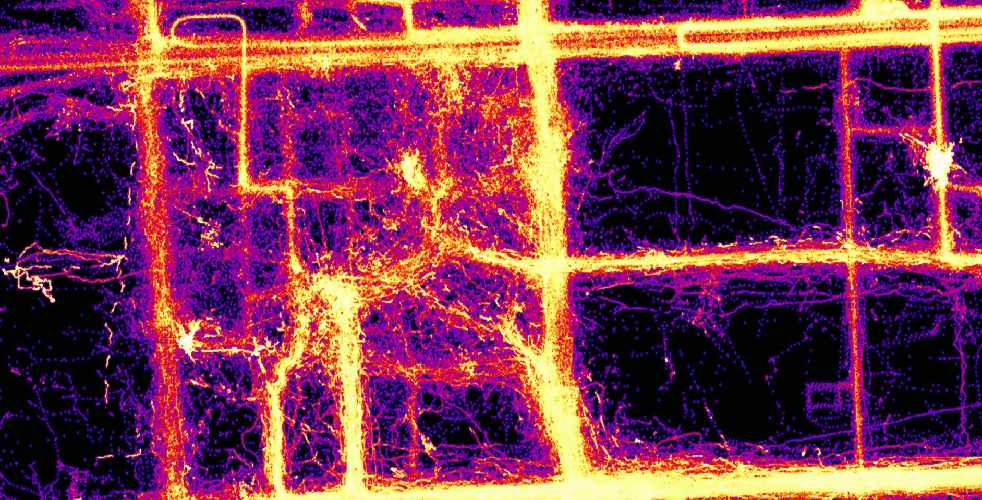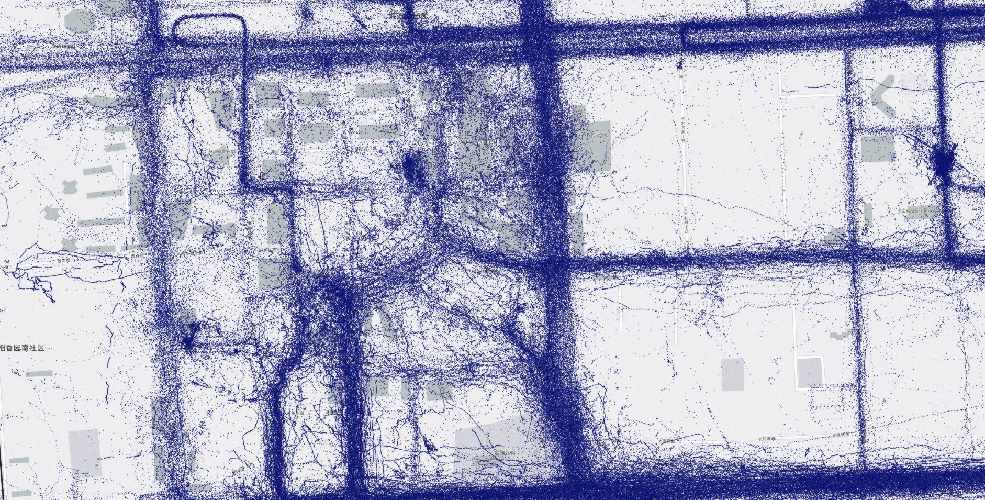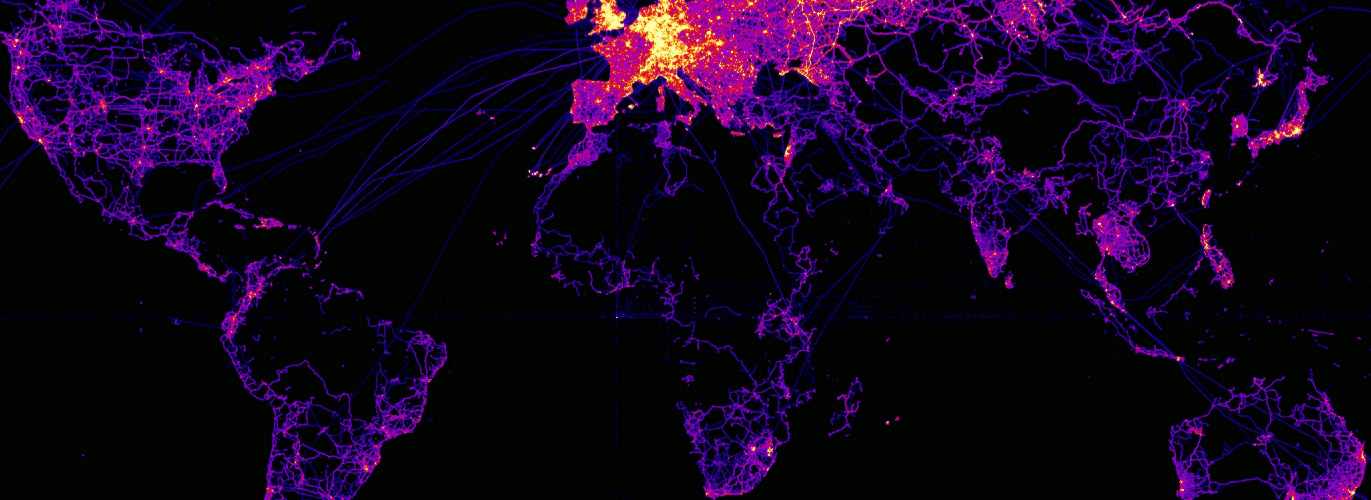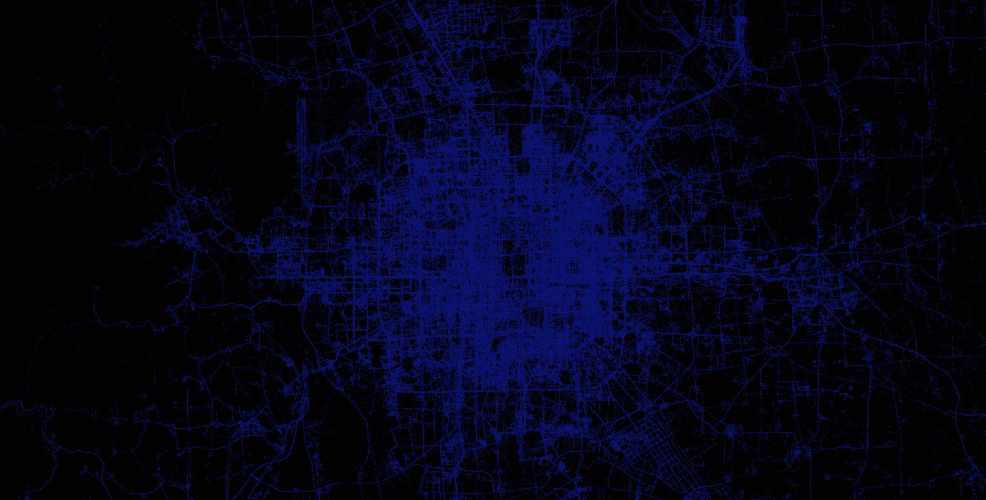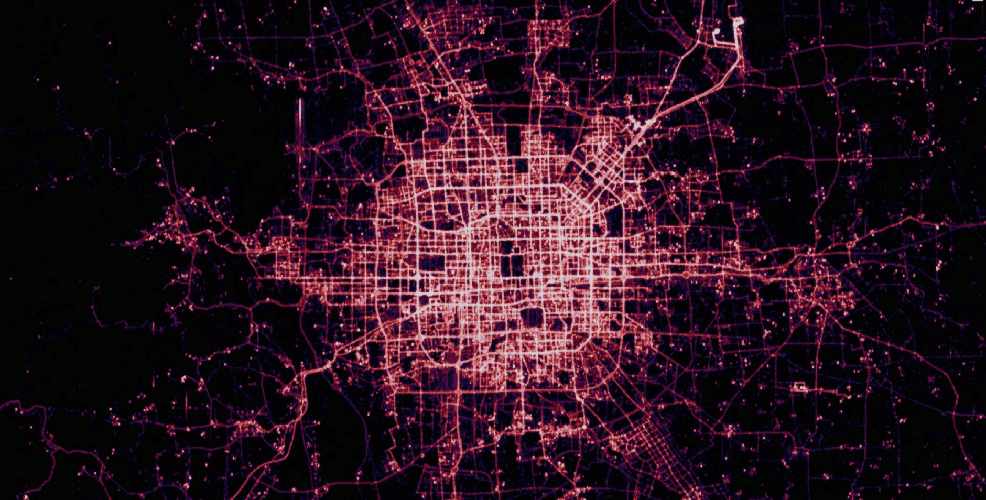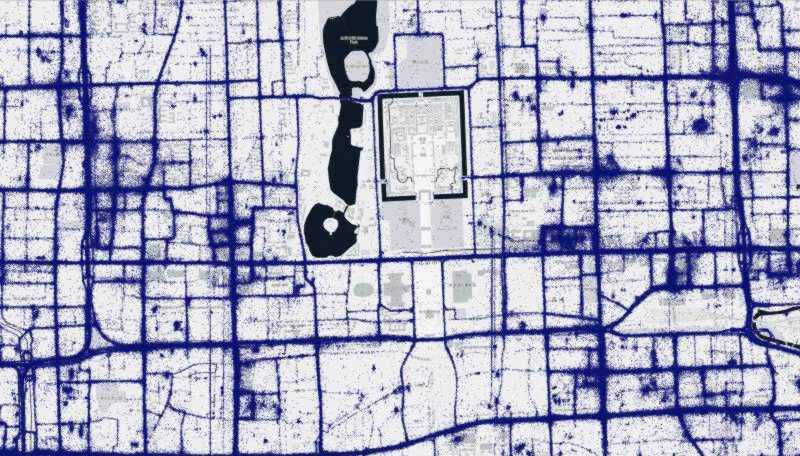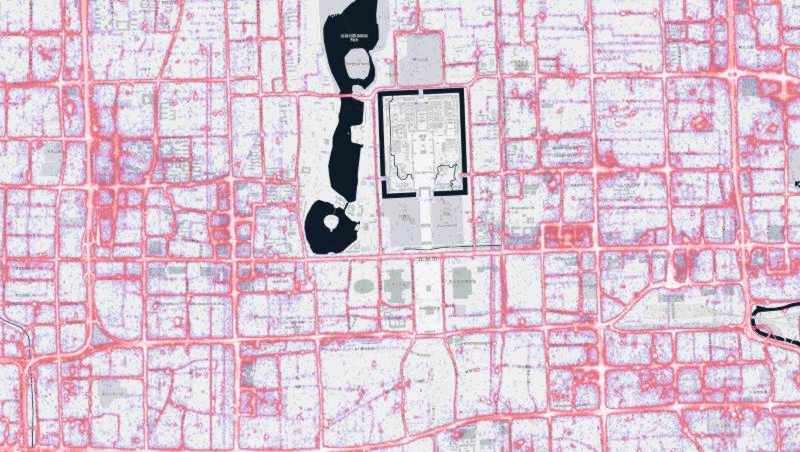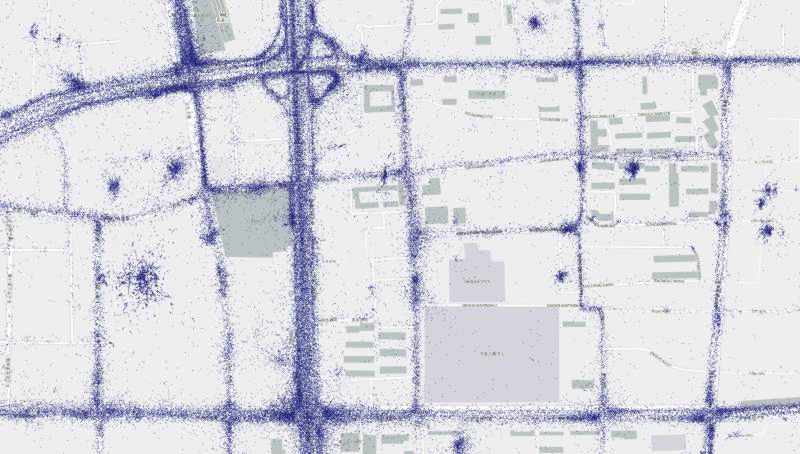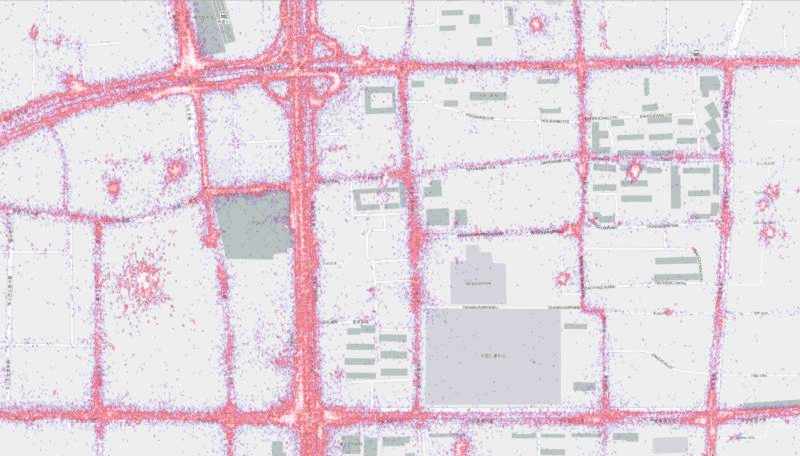What is GeoWave
GeoWave is a library for storage, index, and search of multi-dimensional data on top of a sorted key-value datastore. GeoWave includes specific tailored implementations that have advanced support for OGC spatial types (up to 3 dimensions), and both bounded and unbounded temporal values. Both single and ranged values are supported on all axes. GeoWave’s geospatial support is built on top of the GeoTools extensibility model, so it plugins natively to GeoServer, uDig, and any other GeoTools compatible project – and can ingest GeoTools compatible data sources. GeoWave comes out of the box with an Accumulo implementation.
Features:
-
Adds multi-dimensional indexing capability to Apache Accumulo
-
Adds support for geographic objects and geospatial operators to Apache Accumulo
-
Contains a GeoServer plugin to allow geospatial data in Accumulo to be shared and visualized via OGC standard services
-
Provides Map-Reduce input and output formats for distributed processing and analysis of geospatial data
GeoWave attempts to do for Accumulo as PostGIS does for PostgreSQL.
Origin
GeoWave was developed at the National Geospatial-Intelligence Agency (NGA) in collaboration with RadiantBlue Technologies and Booz Allen Hamilton. The government has unlimited rights and is releasing this software to increase the impact of government investments by providing developers with the opportunity to take things in new directions. The software use, modification, and distribution rights are stipulated within the Apache 2.0 license.
Pull Requests
All pull request contributions to this project will be released under the Apache 2.0 license.
Software source code previously released under an open source license and then modified by NGA staff is considered a "joint work" (see 17 USC 101); it is partially copyrighted, partially public domain, and as a whole is protected by the copyrights of the non-government authors and must be released according to the terms of the original open source license.
Intent
Pluggable Backend
GeoWave is intended to be a multidimensional indexing layer that can be added on top of any sorted key-value store. Accumulo was chosen as the target architecture – but HBase would be a relatively straightforward swap – and any datastore which allows prefix based range scans should be trivial extensions.
Modular Design
The architecture itself is designed to be extremely extensible – with most of the functionality units defined by interfaces, with default implementations of these interfaces to cover most use cases. It is expected that the out of the box functionality should satisfy 90% of use cases – at least that is the intent – but the modular architecture allows for easy feature extension as well as integration into other platforms.
Self-Describing Data
GeoWave also targets keeping data configuration, format, and other information needed to manipulate data in the database itself. This allows software to programmatically interrogate all the data stored in a single or set of GeoWave instances without needing bits of configuration from clients, application servers, or other external stores.
Theory
Spatial Index
The core of the issue is that we need to represent multi-dimensional data (could be (latitude, longitude), (latitude, longitude, time), (latitude, longitude, altitude, time) – or even (feature vector1, feature vector 2 (…) feature vector n)) in a manner that can be reduced to a series of ranges on a 1 dimensional number line. This is due to the way Accumulo (and any big table based database really) stores the data – as a sorted set of key/value pairs.
What we want is a property that ensures values close in n-dimensional space are still close in 1-dimensional space. There are a few reasons for this – but primarily it’s so we can represent a n-dimensional range selector(bbox typically – but can be abstracted to a hyper-rectangle) as a smaller number of highly contiguous 1d ranges.

Figure: Z-Order curve based dimensional decomposition
Fortunately there is already a type of transform that describes this operation in mathematics – it’s called a “Space Filling Curve” – or SFC for short. Different space filling curves have different properties - what they all do is take a n-dimensional space and describe a set of steps to trace all points in a single sequence.

Figure: Haverkort, Walderveen Locality and Bounding-Box Quality of Two-Dimensional Space-Filling Curves 2008 arXiv:0806.4787v2
The trade-offs for the various curves are outside the scope of this user manual, but the paper cited for figure two is an excellent starting point to start learning about these curves.
For the purposes of GeoWave we have implemented two space fillings curves:
Z-Order SFC
This is also commonly called a GeoHash, or Morton order (and sometimes incorrectly called a Peano curve). This is the most popular SFC used for multi-dimensional → 1-dimensional mappings – primarily because it is both intuitive and very easy to implement in code. There are two common ways to implement this – ideally a bit-interleaving is used (that is what gives rise to the diagram in figure 2) – imagine we had two numbers, A and B. Let the binary representation of those numbers be A1A2A3 and B1B2B3. The “bit interleaved” version would be A1B1A2B2A3B3. Since we are working with binary numbers this gives a “unit cell” of 2x2. If we added dimensions just image the same interleaving, but another term - C1C2C3, etc. + This is sometimes implemented in base 10 instead of base 2. This implementation reduces somewhat the locality (“packing property” – or the measure of how close numbers in n-dimensional space are to numbers in 1-dimensional space). As you might expect a two dimensional version of this gives a unit cell of 10x10 (for two dimensions) – hence the worse packing.
Hilbert SFC
The Hilbert curve is a bit more complex to work with than the Z-curve – both when calculating and when performing a decomposition – hence it is less commonly used. Nevertheless it is popular in other areas in computer science where multiple variables need to be set in a linear order – process scheduling for one. A simplistic view of a standard projections of the earth mapped to a Hilbert curve would look something like this – with 4 bits of cardinality per dimension (how many buckets we have)
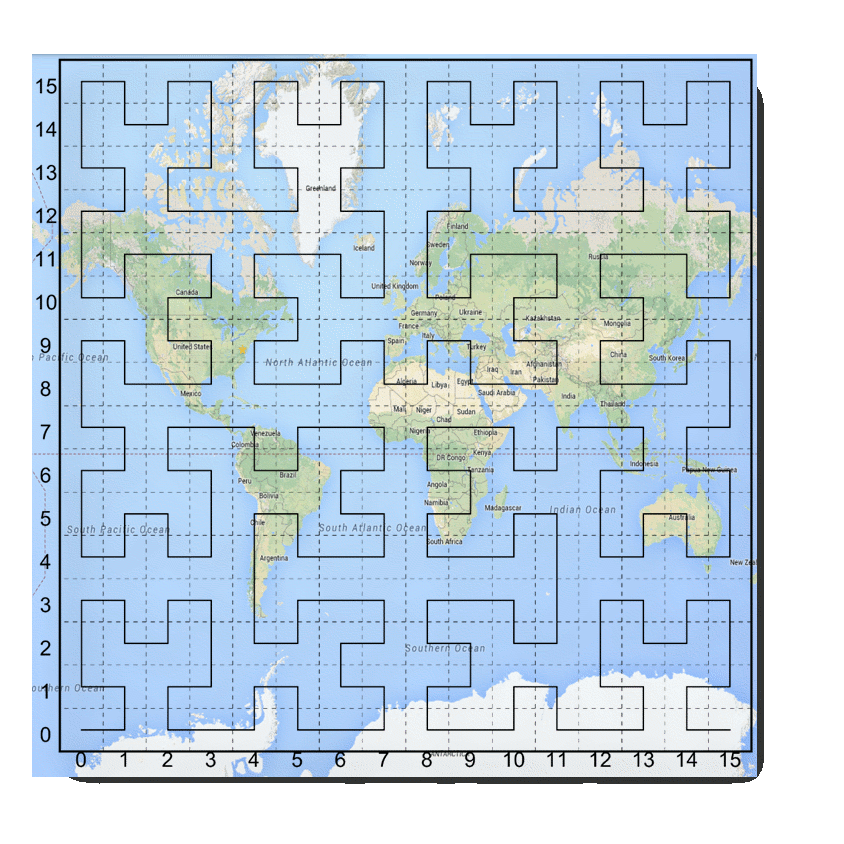
Figure: Hilbert space filling curve superimposed over a projection of the earth
Note that there are the cardinality (number of buckets per dimensions) has an impact on the resolution of our Hilbert index. Here we map from -180 to +180 over 16 buckets – so we have resolution of no better than 360/16, or 22.5 degrees for longitude (and incidentally 11.25 degrees for latitude). This doesn’t mean we can’t represent values more precisely than this – it just means our initial (coarse) index – based on SFC ranges – can’t provide resolution any better than this. Adding more bits per dimensions will increase the precision of the SFC based index.
Decomposition
Core to the concept of SFC based indexing is range decomposition. This is when we take a range described in multiple dimensions and turn it into a series of 1d ranges.
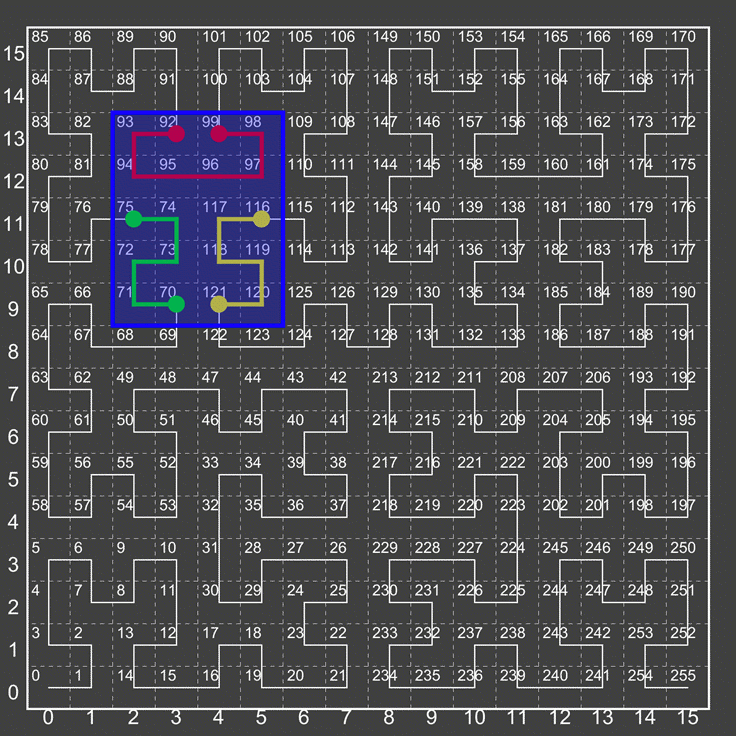
Figure: Hilbert Ranges
In the figure above we show that we mean by this. The bounding box described by the blue selection window – or (2,9) → (5,13) will “fully” decompose to 3 ranges – 70-75, 92→99, and 116→121.
It should be noted that sometimes more simplistic algorithms will not fully decompose – but would instead represent this as 70-121, or even 64→127 (the smallest “unit cell” this box fits in). As you can see this would result in scanning many extraneous cells.
At some point – with high precision high dimensionality curves – the number of possible unit cells can become to large too deal with – in this case GeoWaves optimizes this by treating the curve as a “lower cardinality” curve than it actually is – so the unit cell size might not be 1, but instead 64, 128, 1024, etc. This allows the user to still achieve high precision when selection windows are small, but not spend an inordinate amount of time fully decomposing for large selection windows.
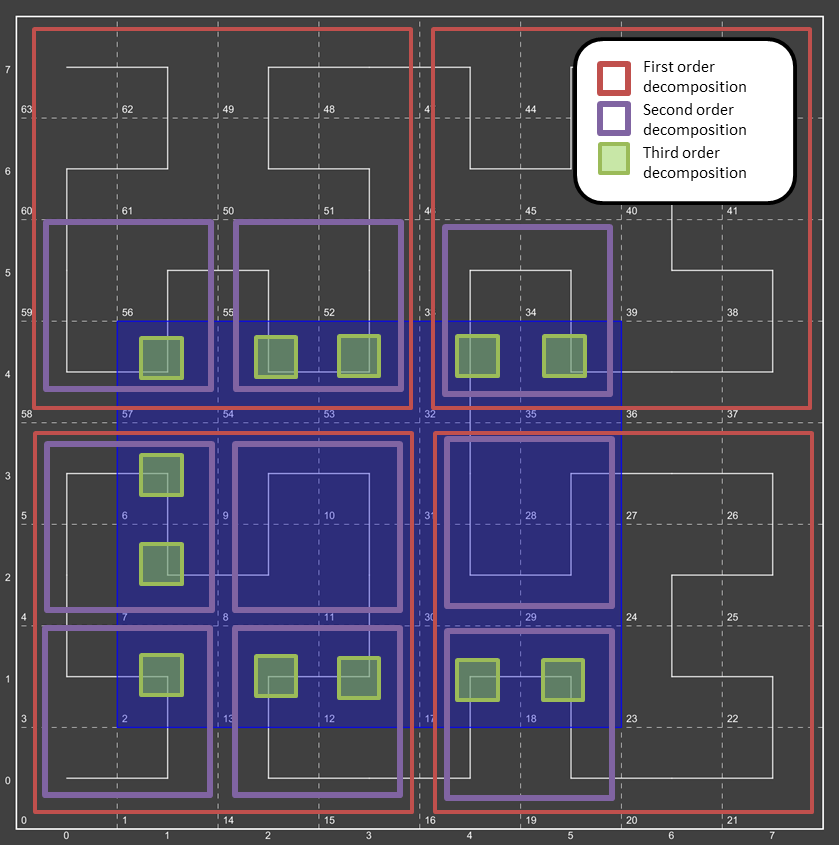
Consider a region query asking for all data from:
(1,1) -> (5,4)
This query range is shown at left by a blue bounding box.
What did we do here?
-
We broke down the initial region into 4 subregions – Red boxes.
-
We broke down each subregion (red box) into 4 sub-sub regions (purple boxes)
-
We then broke down each of those purple boxes into green boxes.
|
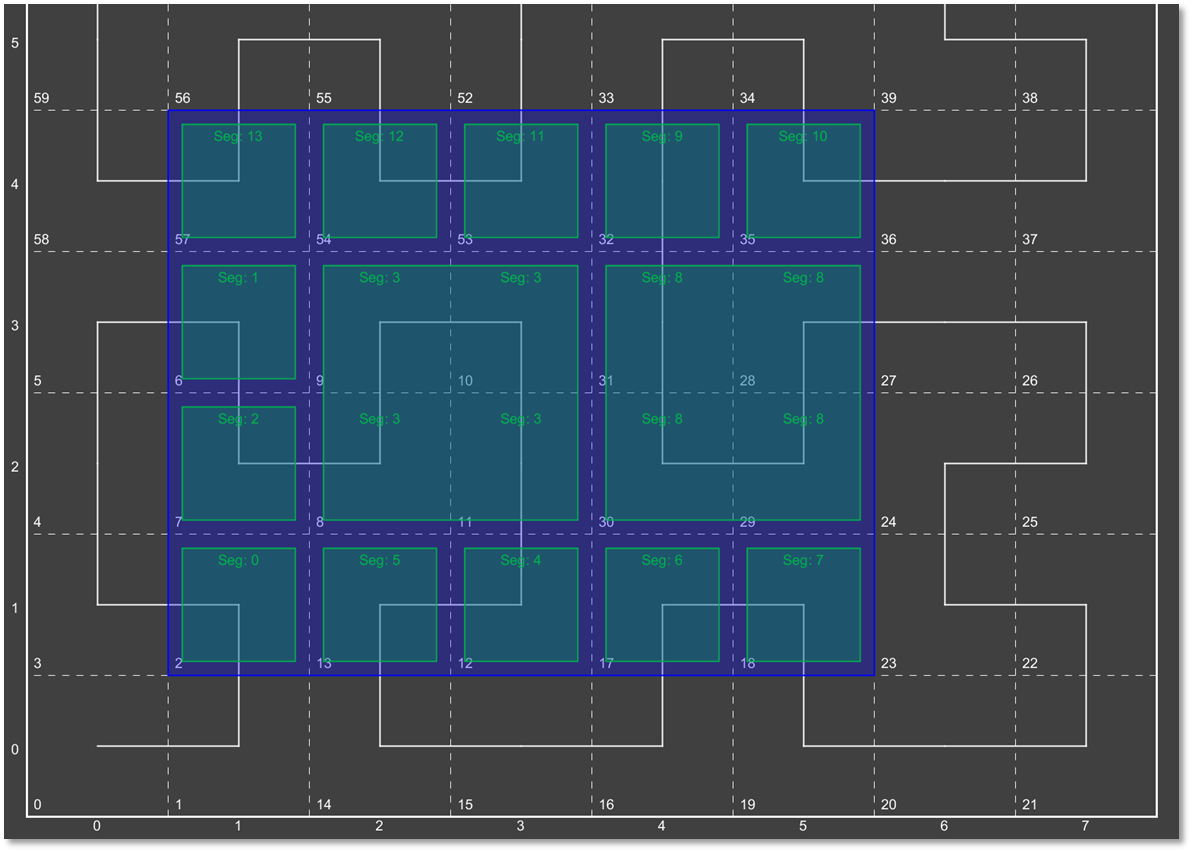
Here we see the query range fully decomposed into the underlying "quads". Note that in some instances we were able to stop decomposing when the query window fully contained the quad (segment 3 and segment 8)
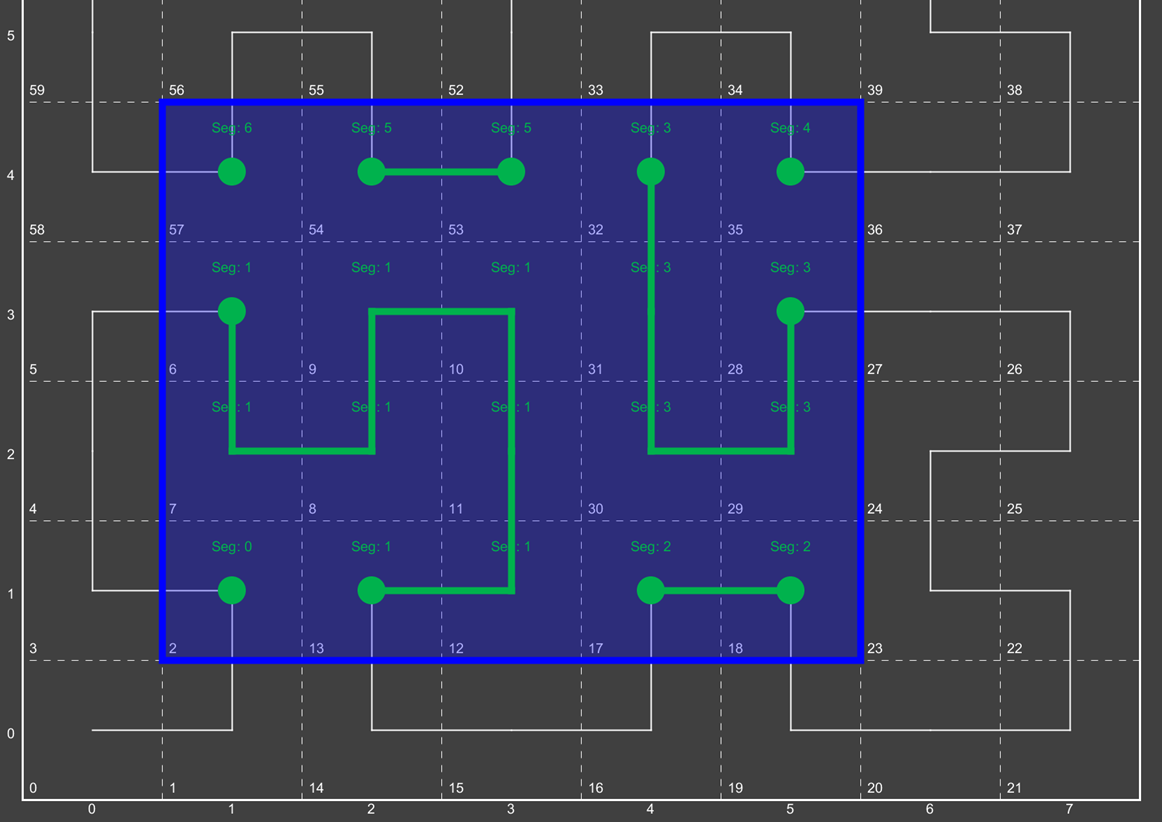
Now we have fully transitioned to the 1d number line from the previous set of quads. We have also rolled together regions which are contiguous.
Screenshots
The screenshots below are of data loaded from the various attributed data sets into a Geowave instance, processed (in some cases) by a Geowave analytic process, and rendered by Geoserver.
GeoLife
Microsoft research has made available a trajectory data set that contains the GPS coordinates of 182 users over a three year period (April 2007 to August 2012). There are 17,621 trajectories in this data set.
More information on this data set is available at Microsoft Research GeoLife page
OpenStreetMap GPX Tracks
The OpenStreetMap Foundation has released a large set of user contributed GPS tracks. These are about 8 years of historical tracks. The data set consists of just under 3 billion (not trillion as some websites claim) point, or just under one million trajectories.
More information on this data set is available at GPX Planet page
T-Drive
Microsoft research has made available a trajectory data set that contains the GPS coordinates of 10,357 taxis in Beijing, China and surrounding areas over a one week period. There are approximately 15 million points in this data set.
More information on this data set is available at: Microsoft Research T-drive page
T-drive at city scale
Below are renderings of the t-drive data. They display both the raw points, as well as the results of a Geowave kernel density analytic. The data corresponds to Mapbox zoom level 12.
Architecture
Overview

At the core of the GeoWave architecture concept is getting data in, and pulling data out – or Ingest and Query. There are also two types of data persisted in the system – feature data, and metadata. Feature data is the actual set of attributes and geometries that are stored for later retrieval. Metadata describes how the data is persisted in the database. The intent is to store the information needed for data discovery and retrieval in the database – so an existing data store isn’t tied to a bit of configuration on a particular external server or client – but instead is “self-describing.”
Indexes
The core engine to quickly retrieve data from GeoWave is a SFC (space filling curve) based index. This index can be configured with several different parameters:
-
number of levels
-
number of dimensions
-
cardinality of each dimension
-
dimension type (bounded / unbounded)
-
value range of each dimension
More on each of these properties will be described later; this list here is just to give the reader a notion of what type of configuration information is persisted.
In order to insert data in a datastore the configuration of the index has to be known. The index is persisted in a special table and is referenced back via table name to a table with data in it. Therefore queries can retrieve data without requiring index configuration. There is a restriction that only one index configuration per table is supported - i.e. you can’t store data on both a 2D and 3D index in the same table. (You could store 2D geometry types in a 3D index though).
Adapters
To store geometry, attributes, and other information a format is needed that describes how to serialize and deserialize. An interface is provided that handles the serialization and deserialization of features. A default implementation supporting the GeoTools simple feature type is also included by default. More on this specific implementation as well as the interface will be detailed later. In the Adapter persistence table a pointer to the java class (expected to be on the classpath) is stored. This is loaded dynamically when the data is queried and results are translated to the native data type
Feature Serialization
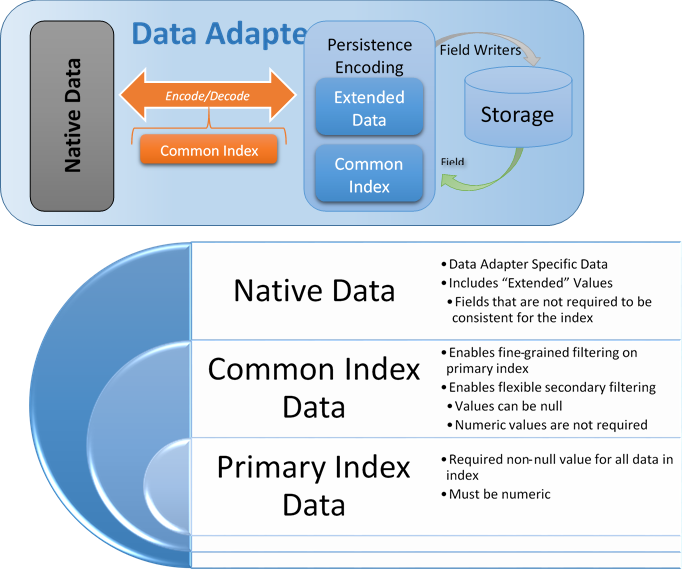
GeoWave allows the user to create their own data adapters - these not only determine how the data is actually stored (serialization/deserialization), but also contain a hierarchy of attribute types. The reason for this hierarchy has to do with extensibility vs. optimization. A data adapter could theoretically take a dependency on ffmpeg, store the feature as metadata in a video stream, and persist that value to the database. All questions of sanity of this solution aside, there are some additional specific issues with the way fine grain filtering is done - specifically due to the iterators. Iterators are part of the Accumulo extensibility module and allow for arbitrary code to be plugged in directly at the tablet server level into the core accumulo kernel. With more code in the iterators there is both a greater chance of crashing (and taking down a tablet server - and possibly an accumulo instance), greater use of memory (memory used by the iterator / class loader isn’t available for caching, etc., and a greater O&M debt - the iterators have to be distributed to each client out of band - and require impersonating the accumulo user (possibly root).
Based on this our target was to minimize the code, and standardize on as few iterators as possible. This conflicted with the desire to allow maximum flexibility with arbitrary DataAdapters. A middle ground was found, and this hierarchy was created. Some standardization was put in place around how certain data types would be stored and serialized, but a "native data" portion was still left in place for arbitrary data - with the caveat that native data cannot be used in distributed (iterator based) filtering - only in client side filtering.
Primary Index Data
These are sets of data which are also used to construct the primary index (space filling curve). They will typically be geometry coordinates and optionally time - but could be any set of numeric values (think decomposed feature vectors, etc.). They cannot be null.
Common Index Data
These are a collection of attributes. There can be any number of attributes, but they must conform to the DimensionField interface - the attribute type must have a FieldReader and a FieldWriter that is within the classpath of the tablet servers. We provide a basic implementation for these attribute types:
-
Boolean
-
Byte
-
Short
-
Float
-
Double
-
BigDecimal
-
Integer
-
Long
-
BigInteger
-
String
-
Geometry
-
Date
-
Calendar
The values that are not part of the primary index can be used for distributed secondary filtering, and can be null. The values that are associated with the primary index will be used for fine-grained filtering within an iterator.
Native Data
These can be literally anything. From the point of view of the data adapter they are just a binary (or Base64) encoded chunk of data. No distributed filtering can be performed on this data except for Accumulo’s visibility filter - but the client side filtering extensibility point can still be used if necessary. The Data Adapter has to provide methods to serialize and deserialize these items in the form of Field Readers and Writers, but it is not necessary to have these methods on the classpath of any Accumulo nodes.
Statistics
Adapters provide a set of statistics stored within a statistic store. The set of available statistics is specific to each adapter and the set of attributes for those data items managed by the adapter. Statistics include:
-
Ranges over an attribute, including time.
-
Enveloping bounding box over all geometries.
-
Cardinality of the number of stored items.
Optional statistics include:
-
Histograms over the range of values for an attribute.
-
Cardinality of discrete values of an attribute.
Accumulo Key Structure

The above diagram describes the default structure of entries in the Accumulo data store. The index ID comes directly from the tiered space filling curve implementation. We do not impose a requirement that data IDs are globally unique but they should be unique for the adapter. Therefore, the pairing of Adapter ID and Data ID define a unique identifier for a data element. The lengths are stored within the row ID as 4 byte integers - this enables fully reading the row ID because these IDs can be of variable length. The number of duplicates is stored within the row ID as well to inform the de-duplication filter whether this element needs to be temporarily stored to ensure no duplicates are sent to the caller. The adapter ID is within the Row ID to enforce unique row IDs as a whole row iterator is used to aggregate fields for the distributable filters. The adapter ID is also used as the column family as the mechanism for adapter-specific queries to fetch only the appropriate column families.
Statistics
Adapters provide a set of statistics stored within a statistic store. The set of available statistics is specific to each adapter and the set of attributes for those data items managed by the adapter. Statistics include:
-
Ranges over an attribute, including time.
-
Enveloping bounding box over all geometries.
-
Cardinality of the number of stored items.
-
Histograms over the range of values for an attribute.
-
Cardinality of discrete values of an attribute.
Statistics are updated during data ingest and deletion. Range and bounding box statistics reflect the largest range over time. Those statistics are not updated during deletion. Cardinality-based statistics are updated upon deletion.
Statistics retain the same visibility constraints as the associated attributes. Thus, there is a set of statistics for each unique constraint. The statistics store answers each statistics inquiry for a given adapter with only those statistics matching the authorizations of the requester. The statistics store merges authorized statistics covering the same attribute.
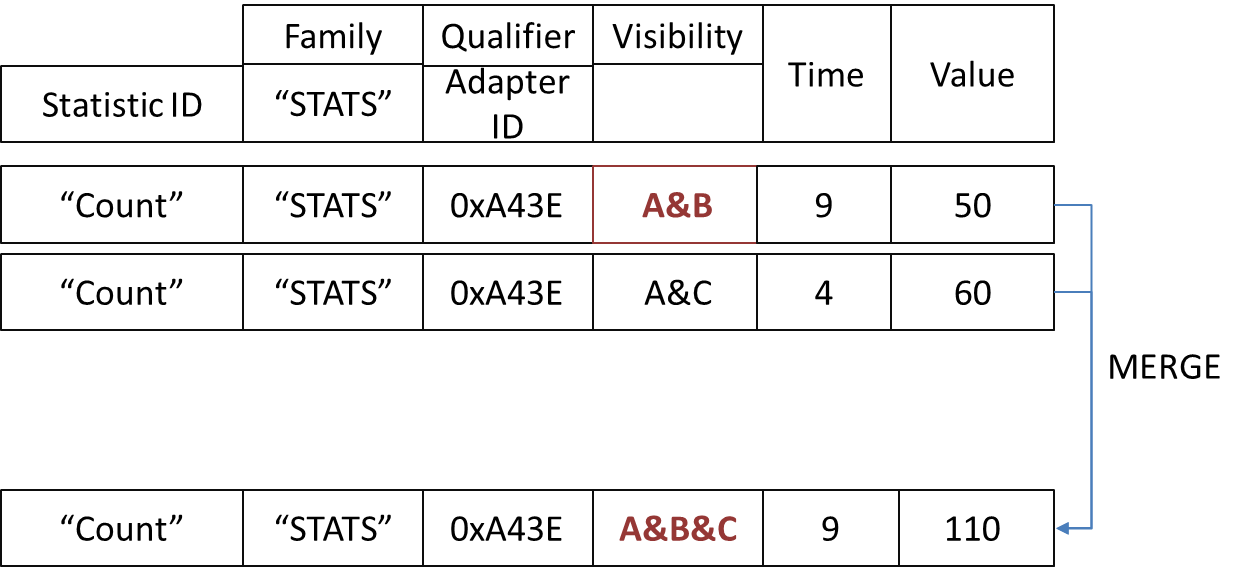
Statistics Table Structure in Accumulo

Re-Computation
Re-computation of statistics is required in three circumstances:
-
As indexed items are removed from the adapter store, the range and envelope statistics may lose their accuracy if the removed item contains an attribute that represents the minimum or maximum value for the population.
-
New statistics added to the statistics store after data items are ingested. These new statistics do not reflect the entire population.
-
Software changes invalidate prior stored images of statistics.
A simple statistics tool is a command line tool to recompute all statistics for a given adapter. The tool is soon to be replaced by a more comprehensive and efficient tool. The tool removes all statistics for adapter, scans the entire data set and reconstructs to statistics. The tool is be executed within a JVM using any of the assembled JAR files. The arguments to the tool are as follow, presented in the exact order required.
-
Zookeepers - Formatted as a comma-separated string: zookeeper1:port,zookeeper2:port
-
Accumulo Instance ID - The "instance" that the Accumulo cluster.
-
Accumulo Username - The nme of the connection user associated with a user account managed by Accumulo, not a system, etc.
-
Accumulo Password - This is an Accumulo controlled secret.
-
Geowave Namespace - This is not an Accumulo namespace; rather think of it as a prefix Geowave uses for index table creation.
-
Geowave Adapter ID - The name of the adapter. This is the local name for the feature name managed by the Feature Data Adapter. This name matches the layer name in GeoServer.
-
Authorizations - Ideally, the requesting authorizations should encompass ALL authorizations of the system. The authorizations may be provided in a comma-separated list.
Make sure JAVA_HOME is set prior to invoking the following command.
java -cp /usr/local/geowave/ingest/geowave-ingest-tool.jar mil.nga.giat.geowave.accumulo.util.StatsTool "localhost:12342" "GeoWave" "root" "pAssWord" "test" "GpxTrack" "A,B&C"
Ingest
Overview
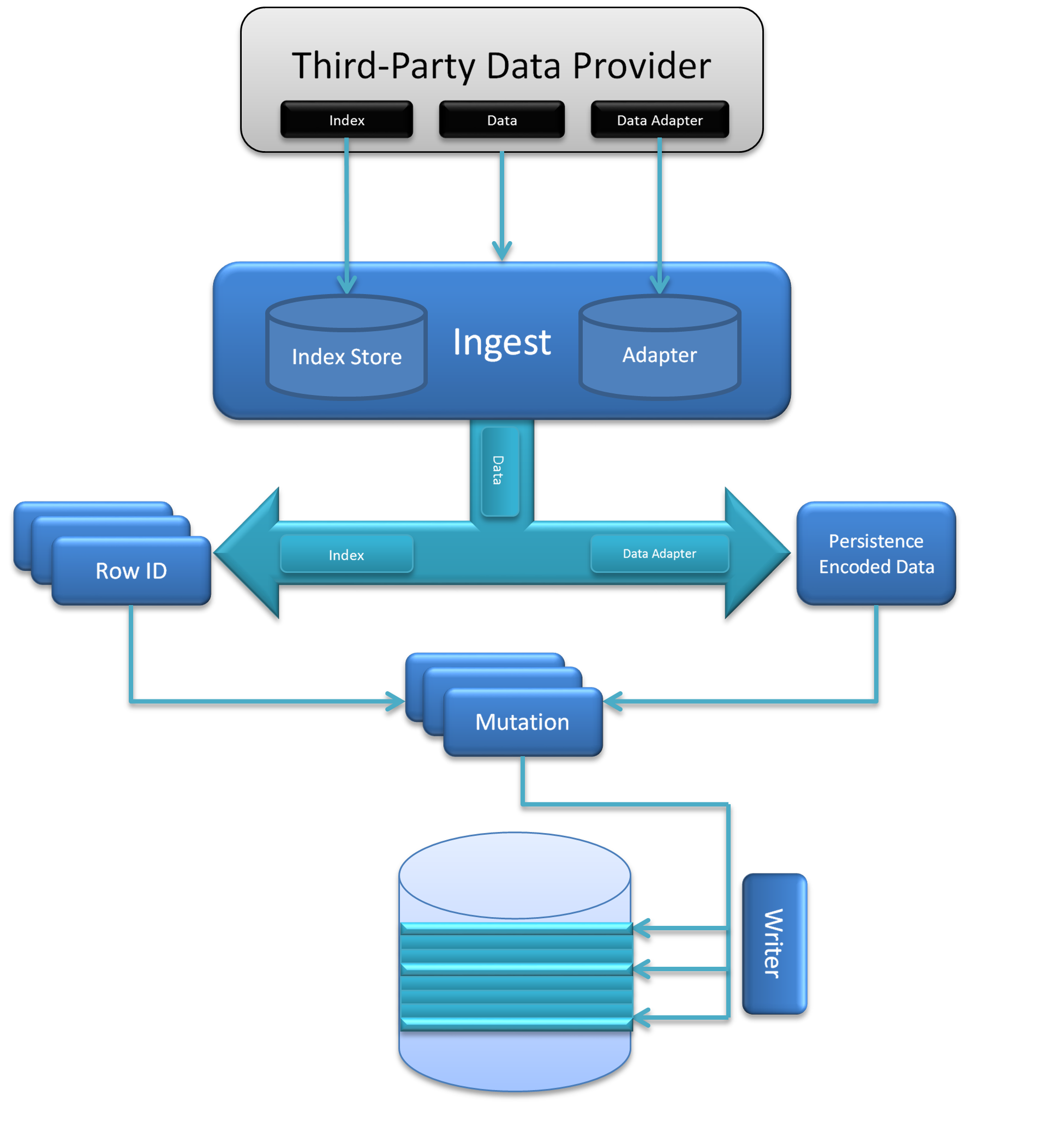
In addition to the raw data to ingest, the ingest process requires an adapter to translate the native data into a format that can be persisted into the data store. Also, the ingest process requires an Index which is a definition of all the configured parameters that defines how data translates to row IDs (how it is indexed) and what common fields need to be maintained within the table to be used by fine-grained and secondary filters.
The logic within the ingest process immediately ensures that the index and data adapter are persisted within the Index Store and the Adapter Store to support self-described data discovery, although in memory implementations of both of these stores are provided for cases when connections to Accumulo are undesirable in the ingest process (such as if ingesting bulk data in a Map-Reduce job). Then the flow determines the set of row IDs that the data will need to be inserted in - duplication is essential under certain circumstances and therefore data may be inserted in multiple locations (for example, polygons that cross the dateline, or date ranges that cross binning boundaries such as December 31-January 1 when binning by year). De-duplication is always performed as a client filter when querying the data. This will be combined with the actual data in a persistable format (after a translation has been performed by the adapter) to create a set of mutations.
There is a Writer interface that the data store’s AccumuloOperations will instantiate which specifies how the mutations will actually be written. The default implementation will wrap an Accumulo BatchWriter with this interface, but in some cases it could make sense to provide a custom implementation of the writer - if performing a bulk ingest within the mapper or reducer of a job, it would be appropriate to define a writer to add the mutations to the context of the bulk ingest rather than writing live to Accumulo.
Framework
A plugin framework (using SPI based injection) is provided, and several methods are supported out of the box. The plugin framework is created in geowave-ingest, and the supported types are in geowave-types.
First we will show how to build and use the built in types, and after that describe how to create a new plugin.
Building ingest framework
This assumes you have already built the main project, if not first do that
| You should either edit the geowave/pom.xml file for the correct Accumulo, Hadoop, GeoTools, and GeoServer versions, or supply command line parameters to override them. |
$ git clone git@github.com:ngageoint/geowave.git
$ cd geowave
$ mvn clean installnow we can build the ingest framework with included types
$ cd geowave-types
$ mvn package -Pingest-singlejarThe ingest file is now packaged in target. When packaged for installation there will be a wrapper script named geowave-ingest
that will be installed in $PATH. In a development environment were this script has not been installed you can use the
artifact directly with the command java -jar geowave-types-VERSION-ingest-tool.jar <operation> <options>
Cmd: geowave-ingest
NAME
geowave-ingest - Ingest data from a local file system or HDFS into GeoWave
SYNOPSIS
geowave-ingest <operation> <options>
DESCRIPTION
The geowave-ingest(1) command will ingest data from a local file system or HDFS into GeoWave
OPERATIONS
- -clear
-
Clear ALL data from a GeoWave namespace, this actually deletes Accumulo tables prefixed by the given namespace
- -hdfsingest
-
Copy supported files from local file system to HDFS and ingest from HDFS
- -hdfsstage
-
stage supported files in local file system to HDFS
- -localingest
-
ingest supported files in local file system directly, without using HDFS
- -poststage
-
ingest supported files that already exist in HDFS
ADDITIONAL
Options are specific to operation choice. Use <operation> -h for help.
The ingest plugin supports two types of ingest, Local and HDFS. Which you use probably depends on the type and amount of data you need to load. The framework handles abstracting across the two methods, so you only need to write the code once.
The hdfsingest option is actually just the hdfsstage and poststage methods chained together. Using them separately is useful if you have a use case to ingest the same data multiple times from hdfs, or if you have a process that has already loaded the data into hdfs.
Each plugin in the ingest framework is required to identify the type of files it can ingest. The coarse filter is based on file extension, and then a secondary filter can be created based on reading the contents of the file.
The intent is to allow the user to point to a directory of files and for the framework to discover and ingest all possible types. The user can explicitly select only certain plugins if they need to narrow this down.
Operation: -clear
NAME
geowave-ingest-clear - Delete existing GeoWave content from Accumulo
SYNOPSIS
geowave-ingest -clear <options>
DESCRIPTION
The geowave-ingest -clear(1) operator will delete all GeoWave data stored in Accumulo for the provided data set
OPTIONS
- -c, --clear
-
Clear ALL data stored with the same prefix as this namespace (optional; default is to append data to the namespace if it exists)
- -dim, --dimensionality <arg>
-
The dimensionality type for the index, either 'spatial' or 'spatial-temporal' (optional; default is 'spatial')
- -h, --help
-
Display help
- -i, --instance-id <arg>
-
The Accumulo instance ID
- -l, --list
-
List the available ingest types
- -n, --namespace <arg>
-
The table namespace (optional; default is no namespace)
- -p, --password <arg>
-
The password for the user
- -t, --types <arg>
-
Explicitly set the ingest type by name (or multiple comma-delimited types), if not set all available ingest types will be used
- -u, --user <arg>
-
A valid Accumulo user ID
- -v, --visibility <arg>
-
The visibility of the data ingested (optional; default is 'public')
- -z, --zookeepers <arg>
-
A comma-separated list of zookeeper servers that an Accumulo instance is using
Operation: -hdfsingest
NAME
geowave-ingest-hdfsingest - Load content from an HDFS file system
SYNOPSIS
geowave-ingest -hdfsingest <options>
DESCRIPTION
The geowave-ingest -hdfsingest(1) operator first copies the local files to an Avro record in HDFS, then executes the ingest process as a map-reduce job. Data is ingested into Geowave using the GeowaveInputFormat. This is likely to be the fastest ingest method overall for data sets of any notable size (or if they have a large ingest/transform cost).
OPTIONS
- -b, --base <arg>
-
Base input file or directory to crawl with one of the supported ingest types
- -c, --clear
-
Clear ALL data stored with the same prefix as this namespace (optional; default is to append data to the namespace if it exists)
- -dim, --dimensionality <arg>
-
The dimensionality type for the index, either 'spatial' or 'spatial-temporal' (optional; default is 'spatial')
- -h, --help
-
Display help
- -hdfs <arg>
-
HDFS hostname and port in the format hostname:port
- -hdfsbase <arg>
-
The fully qualified path to the base directory in HDFS
- -i, --instance-id <arg>
-
The Accumulo instance ID
- -jobtracker <arg>
-
Hadoop job tracker hostname and port in the format hostname:port
- -l, --list
-
List the available ingest types
- -n, --namespace <arg>
-
The table namespace (optional; default is no namespace)
- -p, --password <arg>
-
The password for the user
- -resourceman <arg>
-
YARN resource manager hostname and port in the format hostname:port
- -t, --types <arg>
-
Explicitly set the ingest type by name (or multiple comma-delimited types), if not set all available ingest types will be used
- -u, --user <arg>
-
A valid Accumulo user ID
- -v, --visibility <arg>
-
The visibility of the data ingested (optional; default is 'public')
- -x, --extension <arg>
-
Individual or comma-delimited set of file extensions to accept (optional)
- -z, --zookeepers <arg>
-
A comma-separated list of zookeeper servers that an Accumulo instance is using
ADDITIONAL
The options here are, for the most part, same as for geowave-ingest -localingest, with a few additions.
The hdfs argument should be the hostname and port, so something like "hdfs-namenode.cluster1.com:8020".
The hdfsbase argument is the root path in hdfs that will serve as the base for the stage location. If the directory doesn’t exist it will be created. The actual ingest file will be created in a "type" (plugin type - seen with the --list option) subdirectory under this base directory.
The jobtracker argument is the hostname and port for the jobtracker, so something like mapreduce-namenode.cluster1.com:8021
The hdfsstage and poststage options will just be subsets of this comment; the first creating an avro file in hdfs, the second reading this avro file and ingesting into GeoWave
Operation: -hdfsstage
NAME
geowave-ingest-hdfsstage - Load supported content from a local file system into HDFS
SYNOPSIS
geowave-ingest -hdfsstage <options>
DESCRIPTION
The geowave-ingest -hdfsstage(1) operator copies the local files to an Avro record in HDFS
OPTIONS
- -b,--base <arg>
-
Base input file or directory to crawl with one of the supported ingest types
- -h,--help
-
Display help
- -hdfs <arg>
-
HDFS hostname and port in the format hostname:port
- -hdfsbase <arg>
-
Fully qualified path to the base directory in hdfs
- -l, --list
-
List the available ingest types
- -t, --types <arg>
-
Explicitly set the ingest type by name (or multiple comma-delimited types), if not set all available ingest types will be used
- -x, --extension <arg>
-
Individual or comma-delimited set of file extensions to accept (optional)
Operation: -localingest
NAME
geowave-ingest-localingest - Load content from local file system
SYNOPSIS
geowave-ingest -localingest <options>
DESCRIPTION
The geowave-ingest -localingest(1) operator will run the ingest code (parse to features, load features to accumulo) against local file system content.
OPTIONS
- -b, --base <arg>
-
Base input file or directory to crawl with one of the supported ingest types
- -c, --clear
-
Clear ALL data stored with the same prefix as this namespace (optional; default is to append data to the namespace if it exists)
- -dim, --dimensionality <arg>
-
The dimensionality type for the index, either 'spatial' or 'spatial-temporal' (optional; default is 'spatial')
- -h, --help
-
Display help
- -i, --instance-id <arg>
-
The Accumulo instance ID
- -l, --list
-
List the available ingest types
- -n, --namespace <arg>
-
The table namespace (optional; default is no namespace)
- -p, --password <arg>
-
The password for the user
- -t, --types <arg>
-
Explicitly set the ingest type by name (or multiple comma-delimited types), if not set all available ingest types will be used
- -u, --user <arg>
-
A valid Accumulo user ID
- -v, --visibility <arg>
-
The visibility of the data ingested (optional; default is 'public')
- -x, --extension <arg>
-
Individual or comma-delimited set of file extensions to accept (optional)
- -z, --zookeepers <arg>
-
A comma-separated list of zookeeper servers that an Accumulo instance is using
ADDITIONAL
The index type uses one of the two predefined index implementations. You can perform temporal lookup/filtering with either, but the spatial-temporal includes indexing in the primary index - so will be more performant if spatial extents are commonly used when querying data.
Visibility is passed to Accumulo as a string, so you should put whatever you want in here.
The namespace option is the GeoWave namespace; this will be the prefix of the GeoWave tables in Accumulo. There are a few rules for this that derive from geotools/geoserver as well as Accumulo. To keep it simple if you only use alphabet characters and "_" (underscore) you will be fine.
The extensions argument allows you to override the plugin types, narrowing the scope of what is passed to the plugins
The types argument allows you to explicitly only use certain plugins.
Finally, the base directory is the root directory that will be scanned on the local system for files to ingest. The process will scan all subdirectories under the provided directory.
EXAMPLES
List all of the currently registered as ingest type plugins:
- geowave-ingest -localingest --list
-
geotools-vector: all file-based vector datastores supported within geotools
tdrive: files from Microsoft Research T-Drive trajectory data set
geolife: files from Microsoft Research GeoLife trajectory data set
gpx: xml files adhering to the schema of gps exchange format
geotools-raster: all file-based raster formats supported within geotools
- Load some load data
-
geowave-ingest -localingest -b ./ingest -i instance -n adminborders -p pass -t geotools-vector -u user -z zoo-1:2181
Operation: -poststage
NAME
geowave-ingest-poststage - Ingest supported content that has already been staged in HDFS
SYNOPSIS
geowave-ingest -poststage <options>
DESCRIPTION
The geowave-ingest -poststage(1) operator executes the ingest process as a map-reduce job using data that has already been staged in an HDFS file system
OPTIONS
- -c, --clear
-
Clear ALL data stored with the same prefix as this namespace (optional; default is to append data to the namespace if it exists)
- -dim, --dimensionality <arg>
-
The dimensionality type for the index, either 'spatial' or 'spatial-temporal' (optional; default is 'spatial')
- -h, --help
-
Display help
- -hdfs <arg>
-
HDFS hostname and port in the format hostname:port
- -hdfsbase <arg>
-
Fully qualified path to the base directory in HDFS
- -i, --instance-id <arg>
-
The Accumulo instance ID
- -jobtracker <arg>
-
Hadoop job tracker hostname and port in the format hostname:port
- -l, --list
-
List the available ingest types
- -n, --namespace <arg>
-
The table namespace (optional; default is no namespace)
- -p, --password <arg>
-
The password for the user
- -resourceman <arg>
-
YARN resource manager hostname and port in the format hostname:port
- -t, --types <arg>
-
Explicitly set the ingest type by name (or multiple comma-delimited types), if not set all available ingest types will be used
- -u, --user <arg>
-
A valid Accumulo user ID
- -v, --visibility <arg>
-
The visibility of the data ingested (optional; default is 'public')
- -z,--zookeepers <arg>
-
A comma-separated list of zookeeper servers that an Accumulo instance is using
Ingesting all the things
We can ingest any data type that has been listed as an ingest plugin. Let’s start out with the GeoTools datastore; this wraps a bunch of GeoTools supported formats. We will use the shapefile capability for our example here.
Something recognizable
The naturalearthdata side has a few shapefile we can use use. On the page 50m Cultural Vectors
Let’s download the Admin 0 - Countries shapefile: ne_50m_admin_0_countries.zip
Okay, let’s ingest this. I’ll take some liberty with the file locations, but the process should be obvious
$ mkdir ingest
$ mv ne_50m_admin_0_countries.zip ingest/
$ cd ingest
$ unzip ne_50m_admin_0_countries.zip
$ rm ne_50m_admin_0_countries.zip
$ cd ..
$ geowave-ingest -localingest -b ./ingest -i ACCUMULO_INSTANCE_NAME -n geowave.50m_admin_0_countries -t geotools-vector -u USERNAME -p PASSWORD -z zoo-1:2181Standalone
There are multiple ways to get data into GeoWave. In other sections we will discuss higher order frameworks, mapreduce interfaces, etc. The intent here is "just the basics" - what’s the least framework intensive way that one can load geospatial data.
Information here will reference the SimpleIngest and SimpleIngestProducerConsumer examples in the geowave-examples project.
Minimum information needed
Geowave requires a few pieces of fundamental information in order to persist data - these are:
-
BasicAccumuloOperations object
-
This class contains the information required to connect to an accumulo instance - and which table to use in accumulo.
-
Zookeepers - in the format zookeeper1:port,zookeeper2:port,etc…
-
Accumulo Instance ID - this is the "instance" that the Accumulo cluster you are connecting to was initialized with. It’s a global setting per cluster.
-
Accumulo Username - this is the name of the user you would like to connect as. This is a user account managed by accumulo, not a system, etc. user.
-
Accumulo Password - this is the password associated with the user specified above. Again, this is an accumulo controlled secret.
-
Geowave Namespace - this is not an Accumulo namespace; rather think of it as a prefix geowave will use on any tables it creates. The only current constraint is only one index type is allowed per namespace.
-
-
SimpleFeatureType instance
-
Simple Feature Types are an OGC specification for defining geospatial features. Leveraging this standard is one of the easiest ways to get GIS data into GeoWave
-
SimpleFeatureType instance - org.opengis.feature.simple.SimpleFeatureType - this defines the names, types, and other metadata (nullable, etc) of a feature. Think of it as a Map of Name:Values where the values are typed.
-
DataAdapter instance
-
A geowave data adapter is an implementation of the DataAdapter interface that handles the persistence serialization of whatever the object you are storing.
-
We are storing SimpleFeatures, so can leverage the provided FeatureDataAdapter
-
Index instance
-
The final piece needed - the index defines which attributes are indexed, and how that index is constructed.
-
There are lots of options for index configuration, but for convenience we have provided two defaults
-
DataStore
-
This is the piece that puts everything above together.
-
Initialization required a BasicAccumuloOperations instance, the rest are provided as parameters for calls which need them.
Ingest some data
Here we will programmatically generate a grid of points at each location where a whole number latitude and longitude intersect.
Basic Accumulo Operations
/***
* The class tells geowave about the accumulo instance it should connect to, as well as what tables it should create/store it's data in
* @param zookeepers Zookeepers associated with the accumulo instance, comma separate
* @param accumuloInstance Accumulo instance name
* @param accumuloUser User geowave should connect to accumulo as
* @param accumuloPass Password for user to connect to accumulo
* @param geowaveNamespace Different than an accumulo namespace (unfortunate naming usage) - this is basically a prefix on the table names geowave uses.
* @return Object encapsulating the accumulo connection information
* @throws AccumuloException
* @throws AccumuloSecurityException
*/
protected BasicAccumuloOperations getAccumuloInstance(String zookeepers, String accumuloInstance, String accumuloUser, String accumuloPass, String geowaveNamespace)
throws AccumuloException, AccumuloSecurityException {
return new BasicAccumuloOperations(zookeepers, accumuloInstance, accumuloUser, accumuloPass, geowaveNamespace);
}Simple Feature Type
We know fore sure we need a geometry field. Everything else is really optional. It’s often convenient to add a text latitude and longitude field for ease of display values (getFeatureInfo, etc.).
/***
* A simple feature is just a mechanism for defining attributes (a feature is just a collection of attributes + some metadata)
* We need to describe what our data looks like so the serializer (FeatureDataAdapter for this case) can know how to store it.
* Features/Attributes are also a general convention of GIS systems in general.
* @return Simple Feature definition for our demo point feature
*/
protected SimpleFeatureType createPointFeatureType(){
final SimpleFeatureTypeBuilder builder = new SimpleFeatureTypeBuilder();
final AttributeTypeBuilder ab = new AttributeTypeBuilder();
//Names should be unique (at least for a given GeoWave namespace) - think about names in the same sense as a full classname
//The value you set here will also persist through discovery - so when people are looking at a dataset they will see the
//type names associated with the data.
builder.setName("Point");
//The data is persisted in a sparse format, so if data is nullable it will not take up any space if no values are persisted.
//Data which is included in the primary index (in this example lattitude/longtiude) can not be null
//Calling out latitude an longitude separately is not strictly needed, as the geometry contains that information. But it's
//convienent in many use cases to get a text representation without having to handle geometries.
builder.add(ab.binding(Geometry.class).nillable(false).buildDescriptor("geometry"));
builder.add(ab.binding(Date.class).nillable(true).buildDescriptor("TimeStamp"));
builder.add(ab.binding(Double.class).nillable(false).buildDescriptor("Latitude"));
builder.add(ab.binding(Double.class).nillable(false).buildDescriptor("Longitude"));
builder.add(ab.binding(String.class).nillable(true).buildDescriptor("TrajectoryID"));
builder.add(ab.binding(String.class).nillable(true).buildDescriptor("Comment"));
return builder.buildFeatureType();
}Spatial index
/***
* We need an index model that tells us how to index the data - the index determines
* -What fields are indexed
* -The precision of the index
* -The range of the index (min/max values)
* -The range type (bounded/unbounded)
* -The number of "levels" (different precisions, needed when the values indexed has ranges on any dimension)
* @return GeoWave index for a default SPATIAL index
*/
protected Index createSpatialIndex(){
//Reasonable values for spatial and spatio-temporal are provided through static factory methods.
//They are intended to be a reasonable starting place - though creating a custom index may provide better
//performance is the distribution/characterization of the data is well known.
return IndexType.SPATIAL.createDefaultIndex();
}Data Adapter
/***
* The dataadapter interface describes how to serialize a data type.
* Here we are using an implementation that understands how to serialize
* OGC SimpleFeature types.
* @param sft simple feature type you want to generate an adapter from
* @return data adapter that handles serialization of the sft simple feature type
*/
protected FeatureDataAdapter createDataAdapter(SimpleFeatureType sft){
return new FeatureDataAdapter(sft);
}Generating and loading points
protected void generateGrid(
final BasicAccumuloOperations bao ) {
// create our datastore object
final DataStore geowaveDataStore = getGeowaveDataStore(bao);
// In order to store data we need to determine the type of data store
final SimpleFeatureType point = createPointFeatureType();
// This a factory class that builds simple feature objects based on the
// type passed
final SimpleFeatureBuilder pointBuilder = new SimpleFeatureBuilder(
point);
// This is an adapter, that is needed to describe how to persist the
// data type passed
final FeatureDataAdapter adapter = createDataAdapter(point);
// This describes how to index the data
final Index index = createSpatialIndex();
// features require a featureID - this should be unqiue as it's a
// foreign key on the feature
// (i.e. sending in a new feature with the same feature id will
// overwrite the existing feature)
int featureId = 0;
// get a handle on a GeoWave index writer which wraps the Accumulo
// BatchWriter, make sure to close it (here we use a try with resources
// block to close it automatically)
try (IndexWriter indexWriter = geowaveDataStore.createIndexWriter(index)) {
// build a grid of points across the globe at each whole
// lattitude/longitude intersection
for (int longitude = -180; longitude <= 180; longitude++) {
for (int latitude = -90; latitude <= 90; latitude++) {
pointBuilder.set(
"geometry",
GeometryUtils.GEOMETRY_FACTORY.createPoint(new Coordinate(
longitude,
latitude)));
pointBuilder.set(
"TimeStamp",
new Date());
pointBuilder.set(
"Latitude",
latitude);
pointBuilder.set(
"Longitude",
longitude);
// Note since trajectoryID and comment are marked as
// nillable we
// don't need to set them (they default ot null).
final SimpleFeature sft = pointBuilder.buildFeature(String.valueOf(featureId));
featureId++;
indexWriter.write(
adapter,
sft);
}
}
}
catch (final IOException e) {
log.warn(
"Unable to close index writer",
e);
}
}Other methods
There are other patterns that can be used - see the various classes in the geowave-examples project. The method displayed above is the suggested pattern - it’s demonstrated in SimpleIngestIndexWriter.java
The other methods displayed work, but are either more complicated than necessary (SimpleIngestProducerConsumer.java) or not very efficient (SimpleIngest.java).
Ingest plugins
The geowave-types project comes with several plugins out of the box
$ geowave-ingest -localingest --list
Available ingest types currently registered as plugins:
tdrive:
files from Microsoft Research T-Drive trajectory data set
geotools:
all file-based datastores supported within geotools
geolife:
files from Microsoft Research GeoLife trajectory data set
gpx:
xml files adhering to the schema of gps exchange formatQuery
Overview
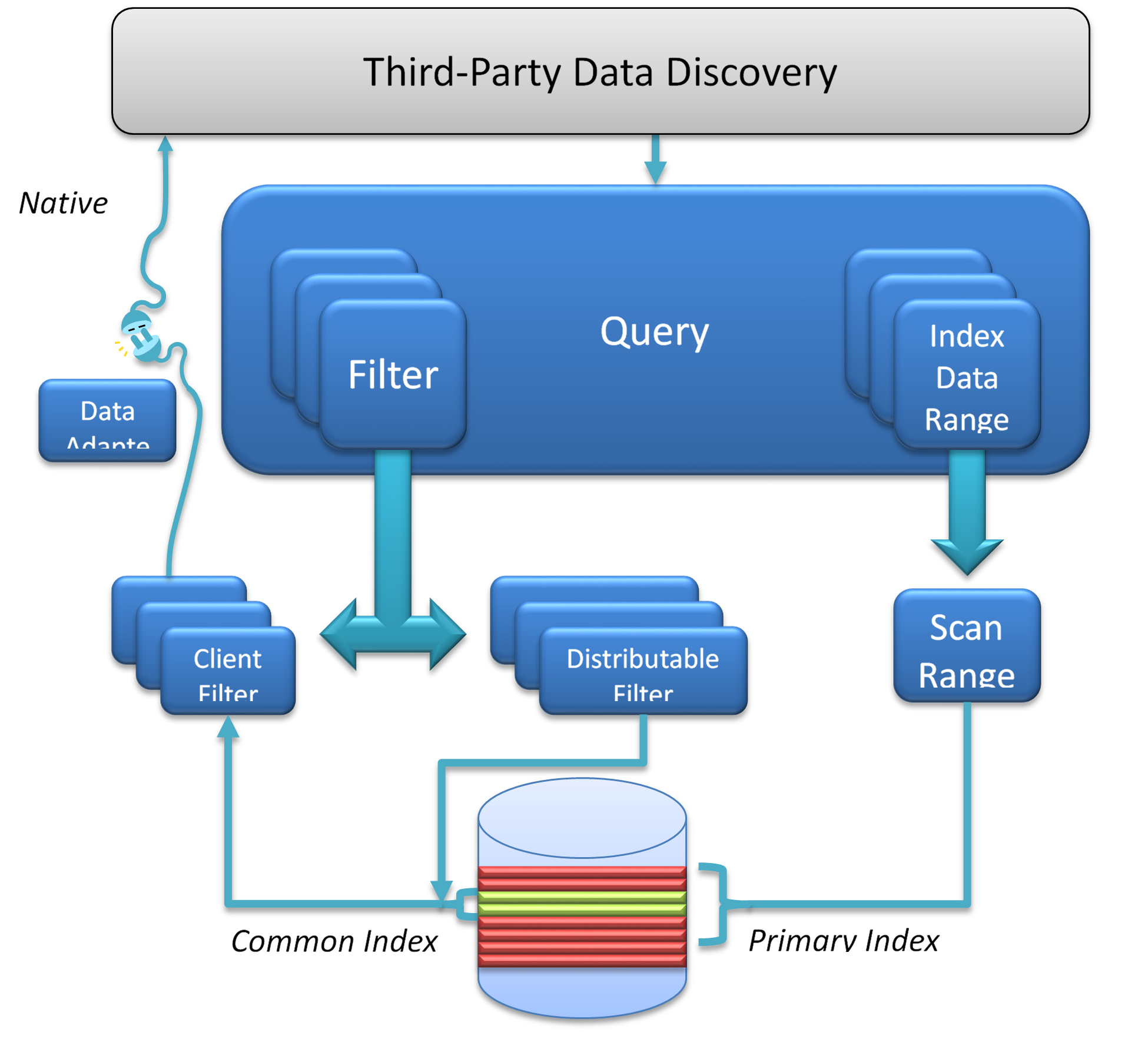
A query in GeoWave currently consists of a set of ranges on the dimensions of the primary index. Up to 3 dimensions (plus temporal optionally) can take advantage of any complex OGC geometry for the query window. For dimensions of 4 or greater the query can only be a set of ranges on each dimension (i.e. hyper-rectangle, etc.).
The query geometry is decomposed by GeoWave into a series of ranges on a one dimensional number line - based on a compact Hilbert space filling curve ordering. These ranges are sent through an Accumulo batch scanner to all the tablet servers. These ranges represent the coarse grain filtering.
At the same time the query geometry has been serialized and sent to custom Accumulo iterators. These iterators then do a second stage filtering on each feature for an exact intersection test. Only if the stored geometry and the query geometry intersect does the processing chain continue.
A second order filter can then be applied - this is used to remove features based on additional attributes - typically time or other feature attributes. These operators can only exclude items from the set defined by the range - they cannot include additional features. Think "AND" operators - not "OR".
A final filter is possible on the client set - after all the returned results have been aggregated together. Currently this is only used for final deduplication. Whenever possible the distributed filter options should be used - as it splits the work load among all the tablet servers.
Third Party
GeoServer
Geowave supports both raster images and vector data exposed through Geoserver.
WFS-T
Extending Geotools, Geowave supports WFS-T for vector data. After following the deployment steps, Geowave appears as a data store type called 'GeoWave Datastore'.
On the Geowave data store creation tab, the system prompts for the following properties.
| Name | Description | Constraints |
|---|---|---|
ZookeeperServers |
Comma-separated list of Zookeeper host and port. |
Host and port are separated by a colon (host:port). |
InstanceName |
The Accumulo tablet server’s instance name. |
The name matches the one configured in Zookeeper. |
UserName |
The Accumulo user name. |
The user should have administrative privileges to add and remove authorized visibility constraints. |
Password |
Accumulo user’s password. |
|
Namespace |
The table namespace associated with this Accumlo data store |
|
Lock Management |
Select one from a list of lock managers. |
Zookeeper is required with a multiple Geoserver architecture. |
Authorization Management Provider |
Select from a list of providers. |
|
Authorization Data URL |
The URL for an external supporting service or configuration file. |
The interpretation of the URL depends on the selected provider. |
Transactions
Most operations under WFS-T use an auto-commit transaction. WFS-T does support long running transactions across multiple requests by using a lock request followed by subsequent use of a provided lock ID. The Geowave implementation supports transaction isolation. Consistency during a commit is not fully supported. Thus, a failure during a commit of a transaction may leave the affected data in an intermediary state—some deletions, updates or insertions may not be processed. The client application must implement its on compensation logic upon receiving a commit-time error response. As expected with Accumulo, operations on a single feature instances are atomic.
Lock Management
Lock management supports life-limited locks on feature instances. There are only two supported lock managers: in memory and Zookeeper. Memory is suitable for single Geoserver instance installations.
Index Selection
Data written through WFS-T is indexed within a single index. The adapter inspects existing indices, finding one that matches the data requirements. A geo-temporal index is chosen for features with temporal attributes. The adapter creates a geo-spatial index upon failure of finding a suitable index. Geo-temporal index is not created, regardless of the existence of temporal attributes. Currently, geo-temporal indices lead to poor performance for queries requesting vectors over large spans of time.
Authorization Management
Authorization Management provides the set of credentials compared against the security labels attached to each cell.
Authorization Management determines the set of authorizations associated with each WFS-T request. The available
Authorization Management strategies are registered through the Server Provider model, within the file
META-INF/services/mil.nga.giat.geowave.vector.auth.AuthorizationFactorySPI.
The provided implementations include the following: . Empty - Each request is processed without additional authorization. . JSON - The requester user name, extracted from the Security Context, is used as a key to find the user’s set of authorizations from a JSON file. The location of the JSON file is determined by the associated Authorization Data URL (e.g. file://opt/config/auth.json). An example of the contents of the JSON file is given below.
{
"authorizationSet": {
"fred" : ["1","2","3"],
"barney" : ["a"]
}
}Fred has three authorization labels. Barney has one.
Visibility Management
Visibility constraints, applied to feature instances during insertions, are ultimately determined a
mil.nga.giat.geowave.store.data.field.FieldWriter, of which there are writers for each supported data type in
Geoserver. By default, the set visibility expression attached to each feature property is empty. Visibility Management
supports selection of a strategy by wrapping each writer to provide visibility. This alleviates the need to extend the
type specific FieldWriters.
The visibility management strategy is registered through the Java Server Provider model, within in the file
META-INF/services/mil.nga.giat.geowave.vector.plugin.visibility.ColumnVisibilityManagement. The only provided
implementation is the JsonDefinitionColumnVisibilityManagement. The implementation expects an property within each
feature instance to contain a JSON string describing how to set the visibility for each property of the feature
instance. This approach allows each instance to determine its own visibility criteria.
Each name/value pair within the JSON structure defines the visibility for the associated feature property with the same
name. In the following example, the geometry property is given a visibility S; the eventName is given a visibility TS.
{ "geometry" : "S", "eventName": "TS" }JSON attributes can be regular expressions, matching more than one feature property name. In the example, all properties
except for those that start with 'geo' have visibility TS.
{ "geo.*" : "S", ".*" : "TS" }The order of the name/value pairs must be considered if one rule is more general than another, as shown in the example.
The rule . matches all properties. The more specific rule geo. must be ordered first.
The system extracts the JSON visibility string from a feature instance property named GEOWAVE_VISIBILITY. Selection
of an alternate property is achieved by setting the associated attribute descriptor 'visibility' to the boolean value TRUE.
Installation from RPM
Overview
There is a public GeoWave RPM Repo available with the following packages.
As you’ll need to coordinate a restart of Accumulo to pick up changes to the GeoWave iterator classes the repos default to
be disabled so you can keep auto updates enabled. When ready to do an update simply add --enablerepo=geowave to your
command.
Examples
# Use GeoWave repo RPM to configure a host and search for GeoWave RPMs to install
rpm -Uvh http://s3.amazonaws.com/geowave-rpms/release/noarch/geowave-repo-dev-1.0-3.noarch.rpm
yum --enablerepo=geowave search geowave
# Install GeoWave Accumulo iterator on a host (probably a namenode)
yum --enablerepo=geowave install geowave-cdh5-accumulo
# Update
yum --enablerepo=geowave install geowave-*
Restart Accumulo service| Name | Description |
|---|---|
geowave-cdh5-accumulo |
Accumulo Components |
geowave-cdh5-core |
Core (home directory and geowave user) |
geowave-cdh5-docs |
Documentation (HTML, PDF and man pages) |
geowave-cdh5-ingest |
Ingest Tool |
geowave-cdh5-jetty |
GeoServer Components |
geowave-cdh5-puppet |
Puppet Scripts |
geowave-cdh5-single-host |
All GeoWave Components |
geowave-repo |
GeoWave RPM Repo config file |
geowave-repo-dev |
GeoWave Development RPM Repo config file |
Installation from Source
GeoServer
GeoServer Versions
GeoWave is currently built against GeoServer 2.6.1 and GeoTools 12.1 with the GeoTools version linked to the GeoServer version. If wish to deploy against a different version simply change the value in the pom and rebuild (see: building) - but no guarantees.
GeoServer Install
First we need to build the GeoServer plugin - from the GeoWave root directory:
$ cd geowave-gt
$ mvn package -Pgeotools-container-singlejarlet’s assume you have GeoServer deployed in a Tomcat container in /opt/tomcat
$ cp target/geowave-gt-*-geoserver-singlejar.jar /opt/tomcat/webapps/geoserver/WEB-INF/lib/and re-start Tomcat
Accumulo Configuration
Overview
The recommended Accumulo configuration for GeoWave requires several manual configuration steps but isolates the GeoWave libraries in application specific classpath(s) reducing the possibility of dependency conflict issues. A single user for all of geowave data or a user per data type are two of the many local configuration options just ensure each namespace containing GeoWave tables is configured to pick up the geowave-accumulo.jar.
Procedure
-
Create a user and namespace
-
Grant the user ownership permissions on all tables created within the application namespace
-
Create an application or data set specific classpath
-
Configure all tables within the namespace to use the application classpath
-
Configure GeoWave transaction support
accumulo shell -u root
createuser geowave (1)
createnamespace geowave
grant NameSpace.CREATE_TABLE -ns geowave -u geowave
config -s general.vfs.context.classpath.geowave=hdfs://NAME_NODE_FQDN:8020/accumulo/classpath/geowave/[^.].*.jar
config -ns geowave -s table.classpath.context=geowave
exit (2)
# From the node with the GeoWave application server installed
java -cp "/usr/local/geowave/geoserver/webapps/geoserver/WEB-INF/lib/*" mil.nga.giat.geowave.vector.plugin.GeoWaveGTDataStore -z ZOOKEEPER_NODE:2181 -i accumulo -u root -p ROOT_PASSWORD -n geowave -m 20| 1 | You’ll be prompted for a password |
| 2 | Done with Accumulo specific configs |
These manual configuration steps have to be performed once after the first install of GeoWave. After the initial install you may elect to do further user and namespace creation and configuring to provide isolation between groups and data sets
Building
GeoWave will shortly be available in maven central (for tagged releases), but until then - or to get the latest features - building GeoWave from source is the best bet.
Application Dependencies
This ultra quickstart assumes you have installed and configured:
-
Java JDK (>= 1.7). The OracleJDK is the most thoroughly tested, but there are no known issues with OpenJDK.
-
Apache Accumulo version 1.5 or greater is required. 1.5.0, 1.5.1, and 1.6.0 have all been tested.
-
Apache Hadoop versions 1.x and 2.x should all work. The software has specifically been run on:
-
Cloudera CDH4 and CDH5 (MR1)
-
MapReduce 1 with the new API (org.apache.hadoop.mapreduce.*) is used. Testing is underway against YARN / MR2 and seems to be positive, but well, it’s still underway.
-
Java Advanced Imaging and Java Image I/O are also both required to be installed on the GeoServer instance(s) as well as on the Accumulo nodes. The Accumulo support is only required for certain functions (distributed rendering) - so this may be skipped in some cases.
Maven dependencies
Required repositories not in Maven Central have been added to the parent POM. Specifically the cloudera and opengeo repos.
Build Process
Checkout geowave, and run a maven install.
$ git clone git@github.com:ngageoint/geowave.git
$ cd geowave && mvn install|
Integration Tests: Windows Integration tests are currently not working on Windows out of the box. If you install cygwin and set the environmental variable CYGPATH to the location of the cygpath binary provided by cygwin then is should work. Eclipse and Avro generated files |
Avro
There are Avro generated sources in the geowave-types project and geowave-ingest. They can be created by running "mvn generate-sources" (and are compiled as part of the standard maven lifecycle normally). Unfortunately, I can’t seem to make eclipse run this portion of the lifecycle on import with the M2E plugin. On first import simply type "mvn generate-sources" at the command line and then refresh your eclipse project.
PDAL
The Point Data Abstraction Library PDAL is a BSD licensed library for translating and manipulating point cloud data of various formats. GeoWave is supported as a plugin for PDAL for both reading and writing data to Accumulo.
Manual Setup
If you want to integrate with the latest version of GeoWave or perhaps a specific branch, you can build the Jace bindings yourself.
Step 1 - Checkout PDAL and GeoWave
First, we need to clone PDAL and GeoWave.
$ git clone git@github.com:PDAL/PDAL.git
$ git clone git@github.com:ngageoint/geowave.gitStep 2 - Build GeoWave
In order to generate the Jace bindings for PDAL, we need to build GeoWave using Maven.
We will also specify two Maven profiles; one which specifies our target platform, and another to specify that we are building PDAL Jace proxies.
Additionally, we need specify the path to the PDAL project.
$ cd geowave
$ mvn clean package -pl geowave-deploy -am -P generate-pdal-proxies,linux-amd64-gcc-debug -Dpdal.directory=/path/to/PDAL -Dmaven.test.skip=trueRefer to the table below to select the platform most applicable to your needs.
| Profile | Generator | Config | Architecture |
|---|---|---|---|
windows-amd64-vc11-debug |
Visual Studio 11 Win64 |
Debug-x64 |
amd64 |
windows-amd64-vc11-release |
Visual Studio 11 Win64 |
Release-x64 |
amd64 |
linux-amd64-vc11-debug |
Unix Makefiles |
amd64 |
|
linux-amd64-vc11-release |
Unix Makefiles |
amd64 |
Step 3 - Configure cmake for PDAL
Once Maven has finished, you will have generated all of the required artifacts for running GeoWave as a PDAL plugin. The artifacts can be found in the target folder within geowave-deploy.
Now that the GeoWave plugin artifacts have been generated, we need to use cmake to configure PDAL to build with our plugin.
To configure PDAL to run with GeoWave, there are a few cmake options which need to be configured. While some of the options (namely the JAVA options) may configure automatically, some will need to be set manually. Refer to the table below to get an idea for how these options would be configured using GeoWave v0.8.3 on Ubuntu 14.04 LTS.
| Option | Value | Automatically Configured? |
|---|---|---|
BUILD_PLUGIN_GEOWAVE |
ON |
|
GEOWAVE_RUNTIME_JAR |
/path/to/geowave/geowave-deploy/target/geowave-deploy-0.8.3-jace.jar |
|
JACE_INCLUDE_DIR |
/path/to/geowave/geowave-deploy/target/dependency/jace/include |
|
JACE_LIBRARY |
/path/to/geowave/geowave-deploy/target/dependency/jace/libjace.so |
|
JACE_RUNTIME_JAR |
/path/to/geowave/geowave-deploy/target/dependency/jace-core-runtime-1.2.22.jar |
|
JAVA_AWT_INCLUDE_PATH |
/usr/local/java/jdk1.7.0_21/include |
X |
JAVA_AWT_LIBRARY |
/usr/local/java/jdk1.7.0_21/jre/lib/amd64/libjawt.so |
X |
JAVA_INCLUDE_PATH |
/usr/local/java/jdk1.7.0_21/include |
X |
JAVA_INCLUDE_PATH2 |
/usr/local/java/jdk1.7.0_21/include/linux |
X |
JAVA_JVM_LIBRARY |
/usr/local/java/jdk1.7.0_21/jre/lib/amd64/server/libjvm.so |
X |
Documentation
Overview
The documentation is writen in AsciiDoc which is a plain-text markup format that can be created using any text editor and read “as-is”, or rendered to several other formats like HTML, PDF or EPUB.
Helpful Links:
Ordering
All of the content stored in the docs/content directory of this project will be rendered into a single web page with
an auto-generated table of contents and a PDF. The order in which the pages appear is determined by the sort order of
the file names given to the ASCIIDOC files in the docs/content directory so a numeric prefix has been given to each
file. Gaps can be left in between the numbers (only the sort order is important) to allow for future edits without having
to renumber other documents that will appear after the new content.
Preview
To preview markup as HTML before making a commit there are plugins available various text editors and IDEs that can be used while editing. If your preferred text editor has no plugin available there’s a Firefox AsciiDoc Plugin available which allows for previewing with a quick refresh of the browser.
Transformation
To preview the entire finished page web page or see the generated PDF you’ll need to run the transformation process.
cd geowave
mvn -P docs -pl docs install (1)| 1 | -pl docs = Process only the docs module. Skips the javadoc generation step. |
The source documents will be transformed and will be available for inspection in the geowave/target/site/ directory.
Site
To build all the content used for the GeoWave website use the following command. The
entire site, including both docs and javadocs, will be available for inspection in the geowave/target/site/ directory.
+[source, bash] +.Generate Website +---- + cd geowave + mvn -P docs install +----
Puppet
Overview
A GeoWave Puppet module has been provided as part of both the tar.gz archive bundle and as an RPM. This module can be used to install the various GeoWave services onto separate nodes in a cluster or all onto a single node for development.
There are a couple of different RPM repo settings that may need setting. As the repo is disabled by default to avoid picking up new Accumulo iterator jars without coordinating a service restart you’ll have to enable and then disable in consecutive Puppet runs to do the initial install.
Options
- hadoop_vendor_version
-
The Hadoop framework vendor and version against which GeoWave was built. Currently only cdh5 is supported
- install_accumulo
-
Install the GeoWave Accumulo Iterator on this node and upload it into HDFS. This node must have a working HDFS client.
- install_app
-
Install the GeoWave ingest utility on this node. This node must have a working HDFS client.
- install_app_server
-
Install Jetty with Geoserver and GeoWave plugin on this node.
- http_port
-
The port on which the Jetty application server will run, defaults to 8080.
- repo_base_url
-
Used with the optional geowave::repo class to point the local package management system at a source for GeoWave RPMs. The default location is http://s3.amazonaws.com/geowave-rpms/dev/noarch/
- repo_enabled
-
To pick up an updated Accumulo iterator you’ll need to restart the Accumulo service. As we don’t want to pick up new RPMs with something like a yum-cron job without coordinating a restart so the repo is disabled by default.
- repo_refresh_md
-
The number of seconds before checking for new RPMs. On a production system the default of every 6 hours should be sufficient but you can lower this down to 0 for a development system on which you wish to pick up new packages as soon as they are made available.
Examples
Development
Install everything on a one node development system, use the GeoWave Development RPM Repo and force a check for new RPMs with every pull (don’t use cached metadata)
# Dev VM
class { 'geowave::repo':
repo_enabled => 1,
repo_refresh_md => 0,
} ->
class { 'geowave':
hadoop_vendor_version => 'cdh5',
install_accumulo => true,
install_app => true,
install_app_server => true,
}Clustered
Run the application server on a different node, use a locally maintained rpm repo vs. the one available on the Internet and run the app server on an alternate port so as not to conflict with another service running on that host.
# Master Node
node 'c1-master' {
class { 'geowave::repo':
repo_base_url => 'http://my-local-rpm-repo/geowave-rpms/dev/noarch/',
repo_enabled => 1,
} ->
class { 'geowave':
hadoop_vendor_version => 'cdh5',
install_accumulo => true,
install_app => true,
}
}
# App server node
node 'c1-app-01' {
class { 'geowave::repo':
repo_base_url => 'http://my-local-rpm-repo/geowave-rpms/dev/noarch/',
repo_enabled => 1,
} ->
class { 'geowave':
hadoop_vendor_version => 'cdh5',
install_app_server => true,
http_port => '8888',
}
}Puppet script management
As mentioned in the overview the scripts are available from within the GeoWave source tar bundle (Search for gz to filter the list) or you could use the RPM package to install and pick up future updates on your puppet server.
Source Archive
Unzip the source archive, locate puppet-scripts.tar.gz and manage the scripts yourself on your Puppet Server
RPM
There’s a bit of a boostrap issue when first configuring the Puppet server to use the geowave puppet RPM as yum won’t know about the rpm repo and the GeoWave Repo Puppet class hasn’t been installed yet. There is an RPM available that will set up the yum repo config after which you should install geowave-cdh-puppet manually and proceed to configure GeoWave on the rest of the cluster using Puppet.
rpm -Uvh http://s3.amazonaws.com/geowave-rpms/release/noarch/geowave-repo-1.0-3.noarch.rpm
yum install geowave-cdh5-puppet